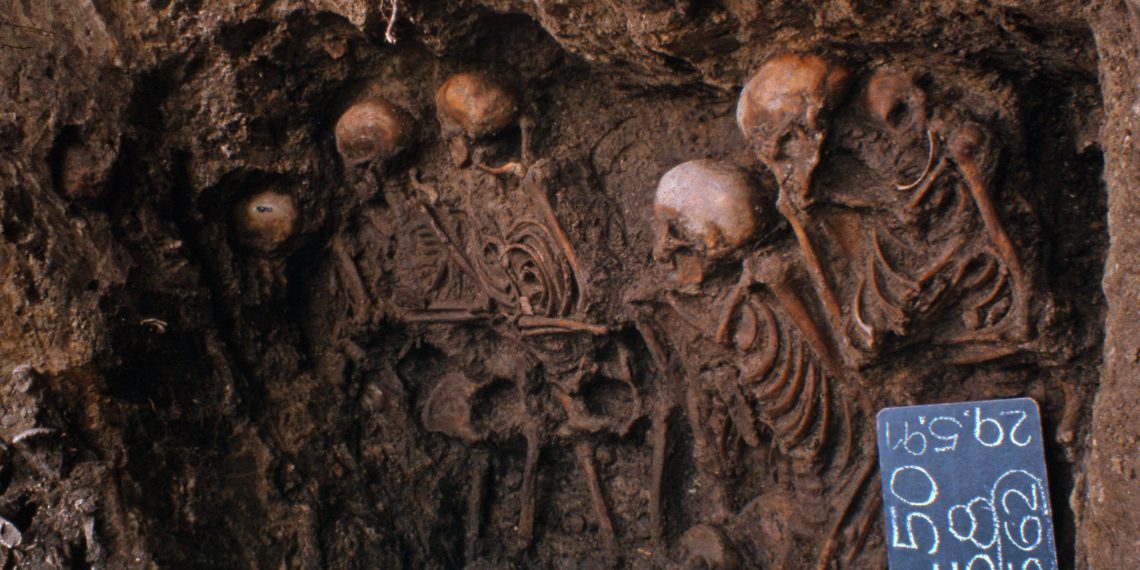Paratyphoid fever is an infectious disease with high fever, abdominal pain and nausea, sometimes also diarrhea, which can be fatal if left untreated. It is similar to the better known typhoid fever, but is caused by a different bacterial pathogen. While paratyphoid fever has become very rare in Germany and Europe today, paratyphoid epidemics continue to occur occasionally in Asia, especially after natural disasters such as floods. In the Middle Ages, however, paratyphoid caused epidemics in Europe with high numbers of victims.
Researchers of the Cluster of Excellence “Precision Medicine in Chronic Inflammation” (PMI) have now for the first time studied human immunogenetics to typhoid fever in Europe in more detail and identified a risk gene that makes people more susceptible to paratyphoid fever. This risk gene is still present in the European population today and at the same time increases the risk for modern inflammatory diseases such as multiple sclerosis or type I diabetes. The team led by Professor Ben Krause-Kyora, an archaeologist and biochemist at the Institute of Clinical Molecular Biology (IKMB) at Kiel Christian Albrechts University (CAU) and Schleswig-Holstein University Hospital (UKSH), Kiel Campus, recently published its findings in the journal Frontiers in Immunology.
In the early 1990s, the remains of numerous people who were buried there in the course of several mass burials in the Middle Ages were found during reconstruction work at the Holy Spirit Hospital in Lübeck. Distributed among various pits of different sizes, a total of more than 800 skeletons of all genders and ages were recovered, which could be dated to the second half of the 14th century. In a previous work, Krause-Kyora’s team isolated and analyzed so-called aDNA, or ancient DNA, from 92 skeletons. This allowed them to identify the causative agent of paratyphoid fever, Salmonella enterica subsp. enterica Paratyphi C, in the remains, showing that the people in the mass grave had died in the wake of a paratyphoid epidemic.
“Now we have also analyzed the genes of these deceased people, which are important for the immune system and thus for fighting such pathogens, using the DNA that is still present.”
- Krause-Kyora, a member of the PMI Cluster of Excellence
In this way, the researchers were able to identify a risk gene that was particularly prevalent in the deceased from the mass grave compared to the overall population at the time. “This gene variant apparently meant that the immune systems of people who had these variants were not as good at fighting off the paratyphoid pathogen and were therefore more likely to contract it,” explains Magdalena Haller, first author of the paper and a doctoral student in the “aDNA Analysis” working group at the IKMB. The gene variant has already been described for people in Asia in connection with paratyphoid fever, but there have been no studies for Europe so far.
The gene variant HLA-DRB1*03:01 is located in the gene region that is important for a specific immune response against bacteria and viruses. With the help of computer modeling, the team was able to find further evidence that people with this variant are less effective at warding off the paratyphoid pathogen.
“We calculated how well the structures encoded by the gene bind to the paratyphoid pathogen,” explains co-author Professor Tobias Lenz from the University of Hamburg and the Max Planck Institute for Evolutionary Biology in Plön, also a member of the PMI Cluster of Excellence. “Thus, we were able to show that the structures encoded by this gene variant presumably bind worse to the pathogen of paratyphoid fever and can therefore fight it more poorly than with other variants of this gene. This would explain why a particularly large number of people with this variant have died from paratyphoid,” Lenz added.
The gene variant that makes people more susceptible to paratyphoid fever is still found in people in Europe today. Studies have shown that it may also play a role in modern inflammatory diseases. For example, it favors unwanted immune reactions to components from food, i.e. food allergies, but also inflammatory diseases such as multiple sclerosis (MS) and type I diabetes. At the same time, however, this variant is also associated with a certain protection against lung diseases such as tuberculosis.
It is precisely because of such connections that Krause-Kyora and his team are studying ancient pathogens and ancient human DNA. “Insights into the evolution of such diseases and the human immune system can contribute to a better understanding of how modern diseases of the immune system, such as chronic inflammatory diseases, develop,” Krause-Kyora explains.

















